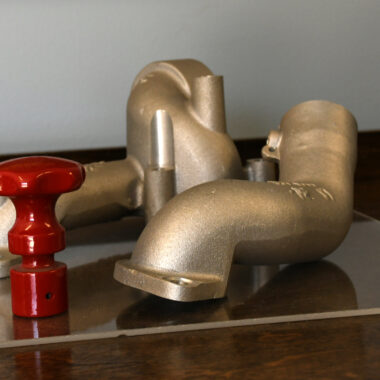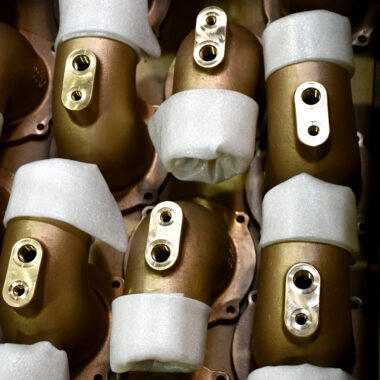About Aluminum Casting Fundamentals: Every Little Thing You Need to Know
About Aluminum Casting Fundamentals: Every Little Thing You Need to Know
Blog Article
Unlocking the Potential of Aluminum Casting: Proven Methods for Success
Aluminum casting has actually long been identified for its flexibility and widespread applications across different industries. Join us as we explore the vital elements that can move light weight aluminum spreading in the direction of unparalleled success in today's affordable market landscape.
Advantages of Light Weight Aluminum Casting
Aluminum spreading offers a wide variety of benefits that make it a recommended selection in various industrial applications. One of the key advantages of light weight aluminum spreading is its light-weight nature, which adds to sustain efficiency in markets such as automobile and aerospace. Furthermore, light weight aluminum is very malleable, permitting complex and elaborate shapes to be easily generated via casting processes. This versatility in layout is a significant advantage for sectors that need parts with details geometries.
Additionally, aluminum casting supplies excellent rust resistance, making it excellent for applications where direct exposure to harsh atmospheres is a worry. The product additionally displays good thermal conductivity, which is beneficial for industries needing warmth dissipation, such as electronics (about aluminum casting). Aluminum is fully recyclable, straightening with the growing focus on lasting methods in modern manufacturing.
Style Factors To Consider for Casting
The design phase plays an important function in the total success of an aluminum casting project. One crucial consideration is the option of proper geometries and functions that assist in the casting process.
Moreover, considerations associated with parting lines, gating systems, and risers are necessary to protect against flaws like porosity and shrinkage. It is essential to enhance the design for efficient material use and lessen post-processing demands. Simulations and prototyping can be beneficial devices in reviewing and refining the spreading style before full-scale manufacturing.
Cooperation between style designers, factories, and makers is crucial to attend to any potential obstacles early in the design stage. By including these considerations into the spreading layout process, makers can boost item top quality, minimize costs, and inevitably open the full possibility of light weight aluminum casting.
Enhancing Casting Effectiveness
When aiming to improve casting efficiency in aluminum casting projects,Creating with an emphasis on optimizing material flow and reducing defects is necessary. To attain this, using simulation software application can assist in recognizing potential problems before the casting process starts. By imitating the circulation of liquified light weight aluminum, designers can adjust gating and riser designs to make sure appropriate filling and solidification, ultimately minimizing the occurrence of defects such as porosity or contraction.
In addition, applying proper heat treatment procedures can improve the overall casting effectiveness. Warmth treatment can aid improve the mechanical residential or read here commercial properties of the light weight aluminum spreading, making sure that the final part fulfills the needed specifications. Additionally, utilizing automation and robotics in the casting process can enhance manufacturing, minimize manual work, and increase overall effectiveness.
Furthermore, continual monitoring and top quality control during the casting procedure are essential for recognizing any deviations and making sure that the last items fulfill the desired standards. By carrying out these methods, producers can enhance casting effectiveness, improve item high quality, and ultimately accomplish greater success in index aluminum spreading tasks.
Quality Assurance in Light Weight Aluminum Casting

Efficient high quality control methods play a crucial role in making certain the precision and integrity of light weight aluminum spreading processes. Quality assurance measures in light weight aluminum casting incorporate a series of tasks aimed at upholding particular standards and identifying variances that could compromise the end product. These techniques begin with the careful selection and inspection of raw materials to assure their top quality and viability for the spreading process. Monitoring and regulating the parameters of the casting procedure itself, such as temperature level, pressure, and air conditioning prices, are essential steps in maintaining consistency and stability in the end products.
In enhancement to procedure control, top quality control in aluminum casting entails strenuous screening and evaluation procedures at various phases of manufacturing. By applying durable quality control techniques, aluminum casting centers can deliver products that satisfy customer expectations for quality, performance, and dependability.
Optimizing Profitability
To attain optimum monetary performance, a detailed method for taking full advantage of profitability within light weight aluminum spreading operations must be carefully developed and carried out. One crucial aspect of taking full advantage of success in light weight aluminum casting is optimizing production performance.

Moreover, diversifying item offerings and checking out brand-new markets can assist broaden earnings streams. Understanding consumer demands and market click to read trends can lead tactical choices to take advantage of on emerging possibilities. Investing in r & d to introduce procedures or products can likewise drive profitability through differentiation and customer contentment.
Conclusion
Finally, light weight aluminum casting offers countless advantages in terms of layout cost-effectiveness, versatility, and sturdiness. By meticulously considering design factors to consider, improving casting efficiency, applying quality control procedures, and maximizing profitability, suppliers can open the complete potential of light weight aluminum spreading. This versatile and reputable process has confirmed to be a successful choice for a wide variety of commercial applications.
Furthermore, light weight aluminum is highly flexible, enabling for elaborate and complex forms to be conveniently produced via casting procedures.Efficient quality control techniques play an essential role in making sure the accuracy and reliability of aluminum casting procedures.In addition to process control, quality control in light weight aluminum casting involves rigorous testing and evaluation procedures at various stages of production. By applying durable quality control techniques, aluminum spreading centers can deliver items that fulfill consumer assumptions for dependability, quality, and performance.
By very carefully taking into consideration layout factors to consider, enhancing casting efficiency, executing top quality control procedures, and maximizing success, manufacturers can open the complete capacity of aluminum casting.
Report this page